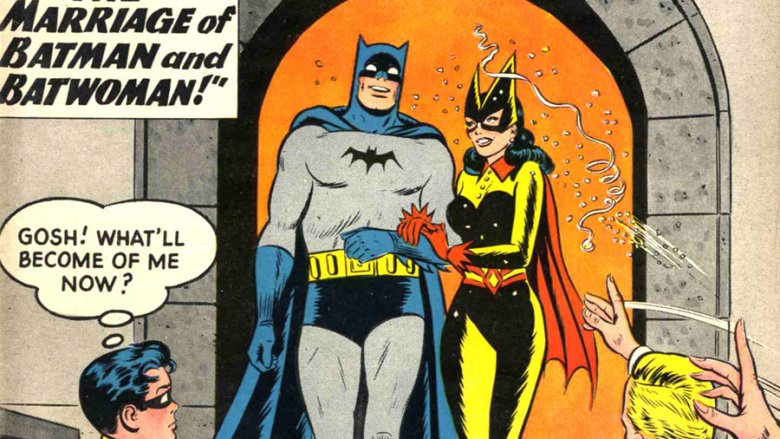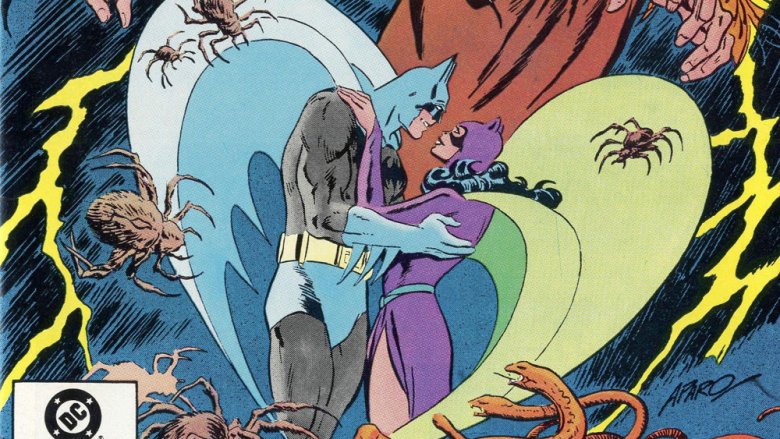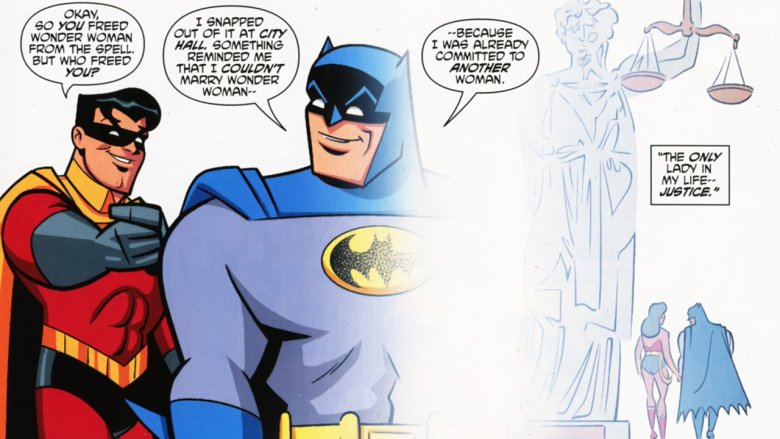That's What's Up: Should Batman Get Married?
Each week, comic book writer Chris Sims answers the burning questions you have about the world of comics and pop culture: what's up with that? If you'd like to ask Chris a question, please send it to @theisb on Twitter with the hashtag #WhatsUpChris, or email it to staff@looper.com with the subject line "That's What's Up."
Q: Should Batman be married? Or even romantically linked to someone else? How has it worked in the past? — Daniel, via email
How has it worked? For Batman, historically speaking, not too well.
Whether he's portrayed as a grim avenger of the night or a world-traveling crimefighter, Batman comics are, at heart, adventure stories, and romance has always been a big part of that genre. For Batman, though, there's a weird catch to it, in that there are always two forces working in opposition. He's a character who's defined by losing his family every bit as much as he's defined by rebuilding one. And that, as you might expect, makes maintaining any romantic relationship, let alone a marriage, pretty difficult. Especially when the most likely prospects are at least technically supervillains.
Single Billionaire Seeks Crime-Fighting Partner… And More?
There's a good reason that all the different crimefighters in Gotham City are called the Batman Family. That idea — family — is at the center of the entire Batman mythology, although it wasn't really there at the beginning. It was in Detective Comics #33, six months after his first appearance, that Bill Finger finally came up with an origin for the new character he'd created with Bob Kane that would set him apart from the characters that inspired him. That was the first of many, many, many times that readers would see Thomas and Martha Wayne get gunned down in Crime Alley. That was Bruce Wayne's defining tragedy, and that in turn means that his ultimate victory, something that goes well beyond just beating up the Riddler, has to be a victory over that — and not just in the idea of Batman confronting the actual guy who pulled the trigger.
In The Caped Crusade, author Glen Weldon argues that Batman isn't really Batman until Robin shows up in 1940, and I'm inclined to agree with him. It was a huge success, redefining the very idea of what a sidekick was and inspiring countless knockoffs, but it also gave Batman himself that victory. From day one, the story of Batman and Robin is the story of Bruce Wayne being a father to someone who had gone through that same tragedy, guiding him through it in the way that no one was there to guide him. That's the start of Bruce recreating his family, and it's safe to say that almost every major addition to his supporting cast has expanded on that role. Just look at Alfred, and how his role evolved from bumbling manservant to surrogate father.
But while Batman would collect his share of kids, dads, and even an all-new, all-different mom over the years — the latter being Mrs. Chilton, one of the most amazing examples of coincidence as plot device to ever hit the comics page — getting married was never really a consideration.
The Dark Knight Settles Down
Part of that just comes down to how the impact of being married on superheroes was viewed back in the Golden and Silver Ages. There was this idea that marriage, as a concept, was diametrically opposed to the very idea of heroic adventures.
If you go back and read any of the Silver Age DC stories about superheroes getting married, it's always portrayed as the absolute worst thing that could happen to them. To be entirely fair, it's not just limited to Superman and Batman, it was also Wonder Woman's stated answer for turning down Steve Trevor's proposals back in the '60s, too. If you want to be downright charitable, you can even point to a tiny seed of logic in the idea — if it were publicly known that Batman or Superman were married, their spouses would inevitably become targets.
Of course, as far as Batman's concerned, that argument doesn't really hold a lot of water when he's already got plenty of loved ones that can (and have) been made into targets, including the literal child he fights crime with every night. It might actually be even worse with Superman, since he tended to pull that excuse out for Lois Lane, who starred in a comic called Superman's Girl Friend Lois Lane. It's not exactly a secret, so at that point, you might as well put a ring on it.
But regardless of those particular excuses, the portrayal of matrimony was always presented as something that would lead inevitably to disaster. In 1959's Batman #122, which contains the story of Batman marrying Batwoman, the marriage lasts all of two days before a strong gust of wind blows off Kathy Kane's cowl, revealing her identity, and her husband's, to Gotham's criminal underworld. It's easy to write that one off, since it's revealed at the end to be a dream that Robin's having, but that's not exactly atypical.
Love in the Time of Villainy
But even with all that, romance is still an important element of the genre — so important, in fact, that the only part of 1966's Batman: The Movie that's played even remotely straight is the part where Bruce Wayne gets his heart broken. If that version of Batman, who is both at his most squarely stentorian and his most swashbuckling, understands that romance is part of the fabric, then you know there's probably something to it. With that in mind, it's not really surprising that the creators of those comics would give him the only kind of romance that wouldn't — that couldn't — lead to a marriage that they so desperately wanted to avoid: Forbidden Love!
Usually, this took the form of a supervillain, or another person who could be conveniently separated from a relationship by Batman's dedication to fighting crime. Talia al-Ghul is a great example of the latter, as she was presented as the most viable long-term love interest while being caught between her love for Batman and her father's globe-spanning criminal empire, but she's definitely not the only one. Given her much more interesting modern portrayal, it's easy to forget that Poison Ivy was introduced as a similarly seductive villainess with designs on luring Batman into becoming half of "the No. 1 Royal Couple of Crime." Even when her character was being revamped in the '80s and '90s, primarily by writer Alan Grant, that was still an aspect. She was presented as a "man-hater," but she made an exception for Batman as what was basically the best possible man, a heaping helping of not-so-subtext that would eventually lead to her becoming canonically bisexual in 2015.
Maybe my favorite version of this sort of character — and probably the second-best Batman love interest of all time — is Silver St. Cloud. She falls in love with Bruce Wayne, realizes that he's Batman, and then winds up leaving him because she understands she'd always come in second place to an obsession with literally ending all crime. As much as she loves Bruce, she values herself more than that life, so she's out. It's a great twist, and one of the reasons she stands out as such a compelling character.
Unfortunately, she wound up in second place anyway, at least as far as Batman's love interests are concerned. There's one I haven't mentioned yet who's pretty conspicuous by her absence, and also about 90 percent of the reason we're all here. So, at long last, let's talk about Catwoman.
The long history of Bat/Cat
Catwoman is, without question, the Forbidden Love character in the Batman mythos, to the point where that relationship has become the archetype of every hero-villain romance in the same way that characters like Superman embody the idea of "superhero." And the thing is, it's pretty much like that from day one.
If you're looking at comics that have a long-term impact, it's hard to beat 1940's Batman #1. That thing has the first Joker story, the first Catwoman story, and the first story where the Joker returns after being presumed dead at the end of a caper. The least important one of the bunch still introduces Hugo Strange, who would go on to become a pretty major villain once he was reintroduced in the '70s. Seriously, though: they knew the Joker was going to be such a big deal that they put his first and second appearances in the same comic. Stump your friends with that one next time you're playing comics trivia.
The Catwoman story is a tidy little mystery built around the twist ending of this mysterious jewel thief being disguised as an elderly lady when she was, in fact, a beautiful young woman! Like Ivy and others would after her, she tempts Batman by offering to run away with him to rule the underworld as the "King and Queen of Crime." Batman says no, of course, but he also admits to being tempted, and when Catwoman makes her daring escape — becoming, I believe, the first criminal to actually get away from him — he just leans back in his seat musing about how beautiful her eyes are.
And this would be their relationship for the next 50 years.
Catwoman '66
It's worth noting that this is an aspect of their characters that made it into Batman '66 in a way that went beyond just the long con of the movie's Kitayna Ireyna Tatanya Kerenska Alisoff, alias Miss Kitka. Instead, there's a running theme of Catwoman almost being willing to give up a life of crime, or Batman almost being willing to give up crimefighting, if only they could reach a compromise. Well, for Julie Newmar's Catwoman, at least. Eartha Kitt's had no time for romance — she was busy trying to forge a full-on criminal empire.
In one of my favorite scenes in the entire series, Newmar's Catwoman just flat-out goes for it, with a ridiculously over-the-top, campy seduction sequence that — because everyone on this show was actually a pretty great actor — still has a ring of earnest desperation. This is a Catwoman who genuinely wants to just leave this whole world of gimmick crimes and Batmobiles behind her and just go live life with someone she's in love with. It's only when Batman asks "what about Robin?" that it all falls apart, because her answer, of course, is a blunt "We'll kill him."
It's a great gag, but it also points to that fundamental difference that stands in the way of their relationship. They're the archetypes they were created to be, implacable crimefighter and femme fatale criminal, as bound to their stories as they are to each other. In that moment, Catwoman could've said anything, but instead, for her, the shortest line between the two points is a quick bit of murder, because that's how villains work. She's an archetype, even if she doesn't want to be.
I could not love that scene more.
Dearly beloved…
The romance was so ingrained in those two characters for so long that it was pretty much assumed by everyone that they'd just wind up getting together eventually. In 1983, Joe Staton, George Freeman, and Alan Brennert — a writer who has written a very small number of Batman comics with a shockingly high percentage of all-time classics — told the story of how it happened, at least for one version of Batman.
"The Autobiography of Bruce Wayne" hit shelves in Brave and the Bold #197 as what is essentially the final story of the Batman of Earth-2 — which, if you're not up on your Infinite Earths, was the home of the original Golden Age Batman. In that story, Batman and Catwoman team up to fight the Scarecrow, and wind up having to face and conquer the one fear at the core of their beings: the fear of letting other people into their lives. And listen, I know that sounds like the corniest thing ever, but trust me, it's great.
Point being, while other versions of Batman and Catwoman would be married, the ones in the core universe would remain apart. She was, after all, a villain. Until she wasn't anymore.
Husband and wife?
To say that Catwoman is popular is underselling by a wide margin. As far as Batman villains go, she is, at worst, a strong second behind the Joker, and third — I don't know, the Penguin? Bane? Two-Face, who would absolutely hate being third? — isn't even close. But when a character is that popular for that long, with a compelling hook and a methodology that's a little easier to forgive than, say, being a genocidal murder clown, they tend to not stay villains forever.
It's worth noting that more often than not, this happens to female characters, and — also more often than not — it happens because of that romantic tension that they have with the hero. It's common enough to be a cliché in its own right, to the point where there's a lot to be said about a lack of villainous women with agency in superhero stories, who aren't just evil until they get seduced back to the side of the angels.
Catwoman, however, has fared better than most, partly because she's a long-running character who was refined over decades, and partly because her "redemption" was never really a betrayal of how she'd existed all along. By the '90s, when she got her own (extremely long-running) solo title, her role as a protagonist was still defined by the kind of outside-the-law self-interest that had always been at the heart of her character. As the rest of Batman's villains got worse (morally speaking), she remained relatively constant.
In other words, she was a criminal, but she was mostly stealing things instead of, you know, cutting off people's faces. On the grand scale of morality in Batman comics, that basically put her half a step below Commissioner Gordon.
Either way, reclassifying her as a protagonist, if not a full hero, made their relationship a whole lot easier to justify, pushing them back toward a destiny that even ye olde shippers of the long-long-ago had wanted since 1940. If Batman was ever going to get married, she would absolutely be the bride. That's probably why they got engaged in 2017, and — spoiler warning for a pretty recent comic book if you haven't already read it — everything else I've just written is probably why that wedding didn't happen as planned.
Forever hold your peace
So all that historical context brings us back to the question we started with: should Batman get married? And if it's not going to be to Catwoman, and it looks like that at least for now, it won't be, then to whom? My answer's actually pretty simple: Sure, why not?
I don't mean that lightly, either. The fact is, at this point, there are very few things that you can do with Batman that haven't been done in some form or another, so at this point, there are at least as many story possibilities that you get from a Batman who's married as there are with a Batman who's single. Maybe even more, considering we've gotten about 80 years of a Bat-chelor already.
There's an idea that getting married "ages" a character in the eyes of the readers, and while that's always been accepted wisdom, I'm not actually sure how true it is — and even if it's 100 percent true, does it actually age a character more than, say, having four sons, two of whom are grown-ass adults? Because if it doesn't, then Batman's probably going to be fine.
I think the bigger problem is the idea that if you do it, it's just going to get undone later, and that has a little more merit to it. Most of the big-name marriages in comics, like Spider-Man's, have been undone through various means. In the case of Superman, who pretty definitively has the One Person to Whom He Absolutely Should Be Married Because She's Been His Primary Love Interest For 80 Years to the Point of Being Synonymous with the Role, the marriage was eliminated by a reboot, then the married versions came back and re-replaced their successors. That was wild, but not quite as wild as the idea that Lois Lane should date Jonathan Carroll, a character whose name you absolutely did not remember until just now. At the same time, if everything's going to be undone, then there's no reason to not do it, either. Just ask Jason Todd.
So yeah. There's no rule in adventure stories that says marriage needs to end the adventure, and if you think having a marriage puts an end to the potential for drama, ask a married person and see what they tell you once they stop laughing. In Batman's case, it would actually be easier for him to carry on as normal if he was married to someone who was also a protagonist who could go off and have her own adventures.
So is it necessary? No, probably not. But at the same time, dude's been in a long-term relationship with Justice for nigh on eight decades. Maybe it's time they open things up a bit.
Each week, comic book writer Chris Sims answers the burning questions you have about the world of comics and pop culture: what's up with that? If you'd like to ask Chris a question, please send it to @theisb on Twitter with the hashtag #WhatsUpChris, or email it to staff@looper.com with the subject line "That's What's Up."








